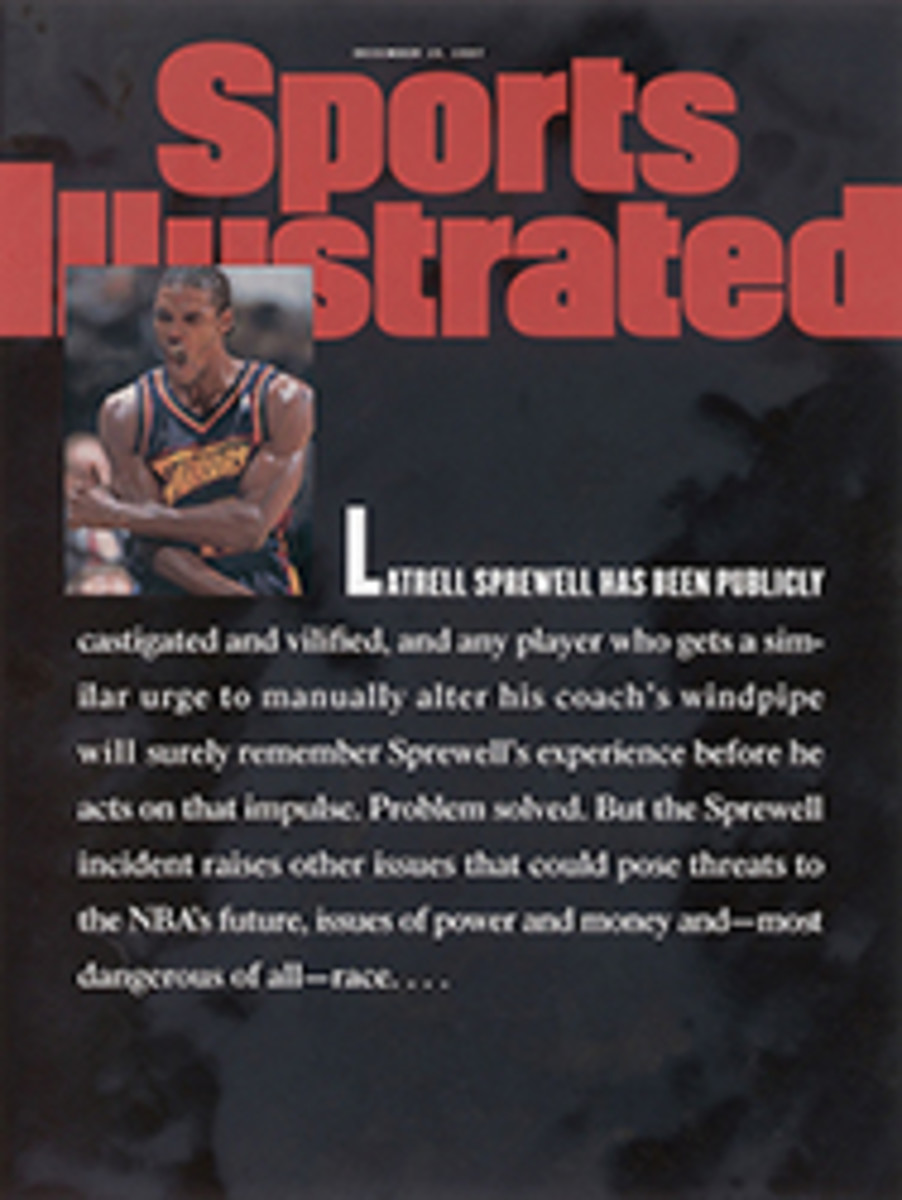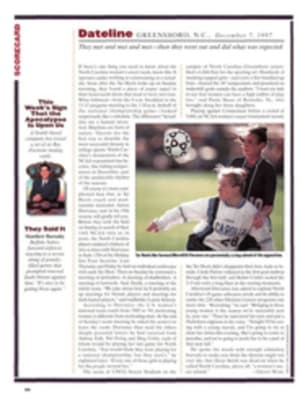
HOME TEAM ADVANTAGE STANFORD IS DOMINATING THE FIELD WITH U.S.-BRED, NOT FOREIGN, TALENT
Vin Lananna has been coaching runners for 22 years, training
bodies and coaxing minds to perform the simplest athletic tasks.
Though he knows practically all the tricks of the trade, he
still gets caught off guard by his brainy runners at Stanford.
Along with the many obvious talents they possess, as measured by
SAT scores, class rankings and stopwatches, they have a gift for
creating cheers. What do you expect from Ted Danson's alma mater?
On Nov. 24, a crisp, bright morning at the Furman University
Golf Course, in Greenville, S.C., the seven runners on the
Stanford men's team gathered in a circle moments before the
start of the NCAA cross-country championships. "Stanford!" they
chanted, then paused two beats. "Machine!"
"I didn't understand it at first," Lananna said later,
chuckling. "I thought the machine was this grinding thing that
was going to roll over things. But that seemed out of character.
Finally they explained it to me: For a machine to work, all the
parts have to work together. They can't work independently. Each
part has to work in concert with the others."
Lananna surely would forgive opposing coaches if they didn't
appreciate this message of New Age harmony, especially after
Stanford edged Arkansas 53-56 to win its second straight men's
cross-country team title. At last year's championships the
Cardinal swept the men's and the women's team titles. This year
the Stanford men were cofavorites, while the women, having
trounced every team they faced this season, were heavy favorites
to repeat. "Are we on the verge of seeing the first great
American distance coach since [former Oregon coach] Bill
Bowerman?" asked Mike Byrnes, editor of Track Digest.
From the gun, the men's 10,000 meters was the most exciting NCAA
cross-country championship race in years, and it produced the
closest team competition since 1970. Back and forth across the
rolling fairways streamed 5,000 exuberant fans, who formed a
moving gantlet that splintered once the leaders had passed and
then came together again at another vantage point. They were
loud too: Long before you could see the leaders, you heard a
roar rolling toward you.
Besides Stanford, three teams were given a chance to win:
Colorado, whose runners had taken the first five places in the
Mountain regional; Michigan, led by Kevin Sullivan, a 3:52 miler
from Canada; and Arkansas, which finished second last year after
winning eight of the previous 12 titles. At the first kilometer
Stanford senior Nathan Nutter and his junior teammates the
co-captain Hauser twins, Brad and Brent, were running
comfortably around 15th place, a fine start except that all
seven Razorbacks were ahead of them. "Our strategy," Lananna
said later, "was to run the hell out of the last half of the
course."
With pale-blue eyes and a white-flecked beard that comes to a
point, Lananna has a vaguely monkish aspect. His normally
articulate runners hesitate when asked why he is such a good
coach, though all agree he is phenomenally driven.
"He focuses on looking straight up and not setting a ceiling,"
says sophomore Michael Stember, who did not run at the NCAA meet
but who, come spring, should be one of the top milers in the
country. "Everyone gets excited about beating the foreigners at
the NCAAs. Well, the point Vin makes is that the Kenyans here
are third- and fourth-echelon. Being All-America has been such a
goal for so many college athletes. To Vin that's not enough."
Lananna grew up in just about the last place you would associate
with cross-country--the Flatbush section of Brooklyn--and was a
good but not outstanding collegiate middle-distance runner at
C.W. Post, clocking 4:17 in the mile. After graduating in 1975,
he spent five years coaching at Post before moving on to
Dartmouth, where he was known for taking good but not
outstanding high school runners and turning them into
All-Americas. In 1986 and '87, Dartmouth, which does not grant
athletic scholarships, finished an astonishing second at the
NCAA cross-country meet. One of Lananna's top runners at
Dartmouth was Bob Kempainen, who has made the last two U.S.
Olympic teams in the marathon.
In 1992 Lananna moved to Stanford, recruited by athletic
director Ted Leland, who had been the athletic director at
Dartmouth while Lananna was there. "Our mission," says Lananna,
"is to have a team every year that makes it to the NCAA meet and
contends." Stanford, of course, is not exactly a tough place to
sell. "I'm two for 159 in recruiting against Vin," one coach on
the East Coast says. "He's got aid packages based on need, just
like the Ivies; he's got true athletic scholarships; he's got a
great academic school and great weather; and he's got that
California mystique. What more could you ask for?"
One thing Lananna does not have is foreign runners, who for
years have been a bone of contention at this meet. Foreign
runners usually dominate the top 10 places, and some coaches
question using scholarship money to develop foreign talent,
instead of homegrown runners. The Texas-El Paso team of 1981,
which set an incomprehensible NCAA championship team record of
17 points (placing 1-2-3-5-6), was made up entirely of Africans.
While there's still some foreign domination--Adam Goucher of
Colorado was the first U.S.-born finisher this year, in fourth
place--Lananna has assembled his juggernaut without using a
single foreigner, though he insists it's a practice based more
on habit than on principle. "We can get the best American kids,
so I don't feel the need to go out and get international kids. I
couldn't give scholarships at Dartmouth," he says, noting that
he did not heavily recruit foreign athletes there because he was
unable to entice them without athletic scholarship money. "If
you don't do something for 12 years, you get used to not doing
it."
It doesn't look as if Lananna's American pipeline is going to
dry up soon. Last spring he scored a middle-distance running
coup. Since the heady days of the mid-'60s, when Jim Ryun, Tim
Danielson and Marty Liquori all broke the four-minute barrier,
high school miling has been in decline. Only in the last two
years has there been a renaissance, and Lananna grabbed three of
the top four guys: 4:02 miler Gabe Jennings and 3:43 1,500-meter
runner Jonathon Riley are Stanford freshmen, while Stember, who
ran a 4:04 mile as a high school junior, is a sophomore.
It's a challenge to control all that raging ambition. To help
his runners bond, Lananna took the team to a two-week altitude
training camp in the Sierra Nevada, east of Palo Alto, Calif.
They stayed in ski condos, cooked for one another and tried to
articulate "the Stanford model," which means something like
emphasizing process over final result. "We couldn't pin it
down," admits Lananna, "so we just called it magic."
They also did a lot of running, not all of it clothed. One team
tradition is the Freedom Run, a romp au naturel, and on this
occasion the men startled some campers. "We're not supposed to
talk about it," says Stember. "But somebody--a freshman--told
Track & Field News, so what can you do? We have a lot of
traditions, things that are confidential. It adds to the
camaraderie."
That camaraderie, plus tremendous patience, paid off in
Greenville. By the end of the first mile most of the Razorbacks
had slipped back through the pack. Seneca Lassiter, the national
1,500-meter champion from Arkansas, ran the final miles with the
glazed eyes of someone who was no longer racing but hanging on.
He finished 78th.
Still, by the five-mile mark, where the course began a steady
climb around a pitted, stubbly field, the top five Razorbacks
had regrouped, and by Lananna's count they led the Cardinal
60-79. "I had Jonathon Riley, our fifth man, in 29th, and Jason
Lunn in 39th," said Lananna later. "I told Jason that if he
passed the Arkansas guy, we'd win. I didn't know that for sure,
but it worked."
Running that last mile like the milers they are, Riley picked
off six runners and Lunn 10. Because of the complications of
scoring a meet with both individual and team contenders, it took
30 minutes to determine which team had won.
As officials reviewed the finish-line videotape and computed the
results, the individual winner held court. Mebrahtom (Meb)
Keflezighi, the diminutive 22-year-old UCLA senior who last
spring became the first man in 12 years to win both the NCAA
5,000 and 10,000 titles, had run the last two miles alone, the
top of his head rarely peeping into view over the spectators'
heads. Keflezighi is a foreign-born runner whom nearly everyone
is happy to have in the NCAAs. His family fled the civil strife
in Eritrea when he was 10, and he graduated from high school in
San Diego. He reached the finish in 28:54, breaking the
16-year-old course record by six seconds.
When word came that Stanford had beaten Arkansas, Keflezighi
broke into a wide grin. "I am happy for the Pac-10," he
explained. "I root for the other runners, just as I am rooting
for Amy now."
He was referring to Arizona junior Amy Skieresz, the prohibitive
favorite for the women's individual title. As a sophomore
Skieresz had won an unprecedented distance quadruple: the NCAA
cross-country, the indoor 5,000 and outdoor 5,000, and the
10,000 title. At two miles into the 5,000 meter race she looked
strong, pulling away to a 30-yard lead. But in the same hilly
field where Riley and Lunn had made their move, Villanova's
Carrie Tollefson learned from screaming onlookers that Skieresz
was only five seconds ahead of her. With a bold dash on the lone
steep hill, some 600 yards from the finish, Tollefson sailed by
Skieresz, winning by 10 seconds in a course-record 16:29.
Tollefson, who plays the trumpet, violin and piano and sings in
a church choir, is the seventh Villanova women's winner in nine
years.
Behind her the team race was between Stanford and Brigham Young.
At the Stanford Invitational in late September, the Cardinal had
taken the first three places against the No. 2-ranked Cougars.
"I think we might have the most talented women's team ever,"
said Lananna the night before the meet. BYU's chances of
toppling the Cardinal seemed slim.
Indeed, Stanford's talented freshman Julia Stamps finished
fourth, and she and her next three teammates outscored their BYU
counterparts 51-67. A strong fifth runner is a cross-country
coach's ultimate blessing, and Lananna, who was tallying the
score feverishly in blue ink on the palm of his hand, knew
things looked grim as he stood at the finish, searching for the
fifth Cardinal to score.
BYU coach Patrick Shane had promised his runners that if they
won, they could shave off his impressive mustache, the only
facial hair allowed by BYU's campus grooming code. When word
finally came that BYU had beaten Stanford 100-102, thanks to
BYU's fifth scorer, Emily Nay, who finished 46th, 18 points
ahead of her Stanford counterpart, the Cougar women gathered
around Shane. "Don't hurt him!" one implored.
First they tried a ladies' electric razor, but it made no
impression on Shane's sturdy mustache. Someone found scissors
and set about lopping it off. "I'm not sure it was worth it,"
Shane said of the victory, endeavoring to move only his lips
while standing perfectly still amid a pack of eager Delilahs.
"Is it gone yet?" he asked.
"No!" they shouted in chorus.
He endured the ordeal bravely. Having won by a hair, the least
he could do was part with a few.
COLOR PHOTO: PHOTOGRAPHS BY BILL FRAKESStanford's runners celebrated with Coach Lananna despite the women's upset loss to BYU. [Vin Lananna and members of track team]
COLOR PHOTO: PHOTOGRAPHS BY BILL FRAKESKeflezighi (left) broke free from Washington State's Bernard Lagat and won the men's individual title. [Mebrahtom (Meb) Keflezighi and Bernard Lagat running]

